“Are there any men in this show?” my dad asked. He’d walked in on me watching a scene in season two of Once Upon A Time, where Emma, Snow White, Mulan, and Sleeping Beauty team up for adventures in the Enchanted Forest without a man in sight. I explained that yes, Snow White was married to Prince Charming, who was currently handling problems in another realm. I was a bit irked that I had to justify this fairy tale girl squad like that. Didn’t he know that fairy tale adaptation was all about empowering women?
Fairy tales and their often-conflated Disney adaptations are held up as feminism’s Public Enemy No. 1. Supposedly, they teach men to be misogynist heroes and girls to be damsels in distress.
But, women worldwide are in distress. Not just from spinning wheels and candy house witches, but from abusive relationships, sexual assault, and education disadvantages and childhood marriage in third-world nations. What’s so wrong about media that portrays men as knights in shining armor helping women out of their distress, so long as female characters are interesting and three dimensional in their own right?
Emma Watson speaking before the UN (left) and teaching a girl to read as Belle (right).
In 2014, Beauty and the Beast actress Emma Watson spoke before the UN, promoting feminism among men and boys with her He for She campaign. Watson said, “We want to try and galvanize as many men and boys as possible to be advocates for change.” According to Watson, men are also imprisoned by gender stereotypes and women shouldn’t be solely accountable for taking themselves out of distress. “I want men to take up this mantle so that their daughters, sisters, and mothers can be free from prejudice, but also so that their sons have permission to be vulnerable and human, too. We claim those parts of themselves that they abandoned.”
Fairy tale media has neglected men, empowering princesses while confining men to a narrower and narrower idea of what it means to be a Prince Charming. When Cinderella confronts her prince for cheating on her in Into the Woods, he tells her, “I was raised to be charming, not sincere.” That play debuted in 1986, and modern TV shows, from the children’s show Ever After High to the very adult Disenchantment, still portray “Prince Charmings” as vain, moronical, or lecherous.
Disenchantment’s Princess Bean kicks off the series dragging her feet to an arranged marriage with Prince Guysbert of Brentwood, a slack-jawed moron who’s can barely string words together to form a sentence. Her wedding dress during this scene is a clear shout-out to the Disney Cinderella’s ball gown, which makes Guysbert a stand-in for Prince Charming.
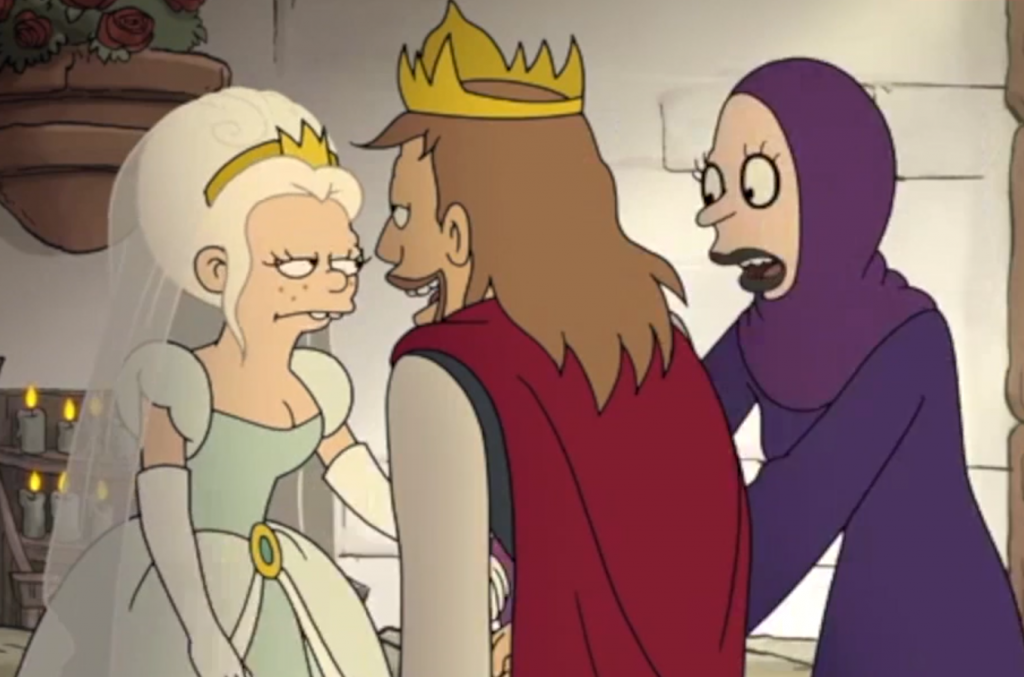
Their planned wedding falls through when Bean smacks the ring out Guysbert’s hand and he impales his head on a throne made of swords while trying to pick it up. Though he protests that he’d be fine if someone would just slide his head up, nobody from the wedding party makes any move to help him. His parents solve the problem by ushering forward Prince Merkimer, Guysbert’s little brother, to marry Bean while his brothers lies impaled and protesting only a few feet away. Merkimer is perverted narcissist who attempts to cheat on Bean with thirty mermaids as she looks on. His “mermaids” are actually walruses, which makes Guysbert actually the less stupid of the two brothers. Fortunately for Bean, Merkimer transforms into a pig and she doesn’t have to marry him either. The castle wizard makes no attempt to transform him back into a human. The parents of these idiot princes leave Merkimer to wander the castle courtyard in pig form and Guysbert is stuck with a sword in his head for nine episodes. Bean and her friends ignore Guysbert, even joking about him being dead (though he’s very much alive) while playing a game of impersonations in episode six.
Bean: Who’s this? (groans) I got killed by a chair.
Luci: Oh, oh, oh! One of your fiances? That guy you murdered? What’s-his-name, the forgettable…Guysbert!
They only pay him attention three episodes later when they need a test subject for an elixir of life–which fails, finally putting poor Guysbert out of his misery. Princes, it seems, are not worth rescuing.
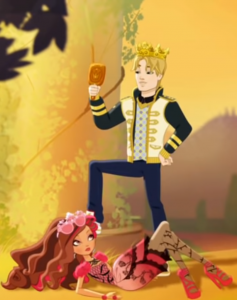
Ever After High has few male characters, as the show is designed to sell dolls for little girls. Prince Daring Charming, initially presented as Apple White’s prince, is somewhat heroic. He’s good at catching girls who fall out of windows, a recurring problem at Ever After High, but he remains a static, narcissistic character throughout years of webisodes and four seasons of the Netflix series. He carries around a tote bag full of mirrors and spends most of his time gazing on himself, until Apple White falls into a cursed sleep and Daring is called upon to do something useful for once. But his kiss fails to wake her, triggering a breakdown in Daring. If he can’t wake a princess, what is he good for, really? While he’s freaking out, his little sister, Darling Charming, steps in to save the day. Darling feels restricted at a school where girls are literally required to take a Damsels in Distress class and has been shown in the past to impersonate her brother when the class needs a guest hero. Here she takes doing her brother’s job one step further and successfully wakes Apple with a CPR-style kiss.
Darling getting to save the day is all well and good her (and Apple, who’s no longer in a coma) but devastating for Daring. As Prince Charming, Daring defines himself by two traits: his heroism and good looks. When Darling does his job for him, he falls into an existential crisis. What is a man good for once women are empowered to perform the same roles? Daring goes into a downward spiral and is only able to find solace in his own good looks-until he’s cursed to transform into a hideous beast. His classmate Rosabella Beauty helps Daring break his curse by teaching him to be less self-absorbed, revealing that Daring is actually the prince of Beauty and the Beast, not Snow White’s tale, as both he and the audience believed for years. His problem is not that he’s a bad prince, but that he’s spent his life evaluating himself based on a gender archetype that he’s not actually suited to.
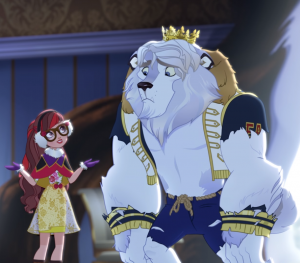
Daring’s existential crisis reflects that of a rising generation of boys unsure of their place in the world of girl power. Fairy tale author Shannon Hale, who wrote a series of Ever After High tie-in novels, has blogged about her male fans being ashamed to admit they read fairy tale books. “I think most people reading this will agree that leaving the the boys behind is wrong. And yet–when giving books to boys, how often do we offer ones that have girls as protagonists? (Princesses even!)”
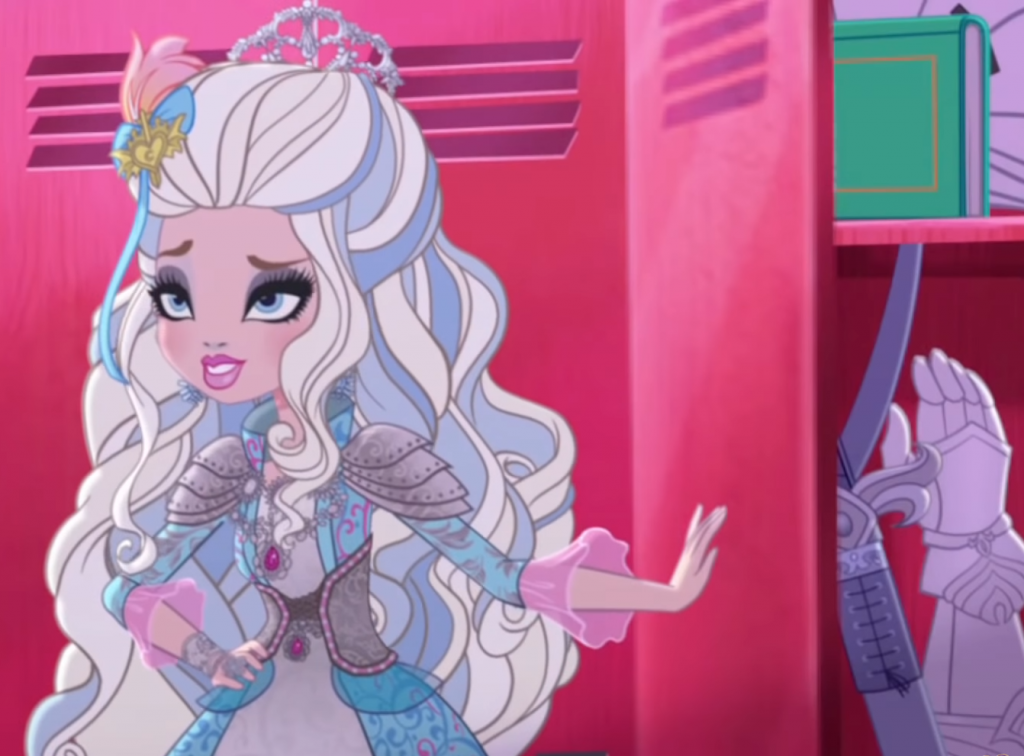
Darling Charming’s taking over her brother’s role is presented as an empowering subversion of fairy tale gender roles, but subversions only work if an audience has been trained to expect them. Today’s little girls don’t know anything about twentieth century ideas of what it meant to be a princess-until modern media reminds them. Darling running around in a suit of armor is something she has to do in secret, lest she fail Damsel in Distress class. Showing her heroism as an act of rebellion, rather than something natural for a girl of Darling’s courage and athleticism, portrays female heroism as an exception rather than the norm. And she’s never allowed to be a hero in her own right. Her every success steals away her brother’s competence.
Wouldn’t it set a more powerful example for young girls, and young boys, to show male and female fairy tale characters helping each other out of distress as equal partners? After decades of adapting fleshed-out fairy tale females, it’s high time we bring back the knights in shining armor and let Prince Charming be a virtuous hero in his own right.

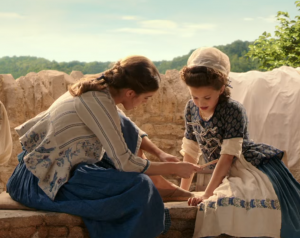
Leave a comment